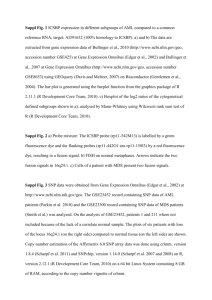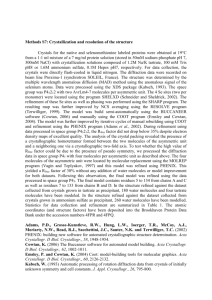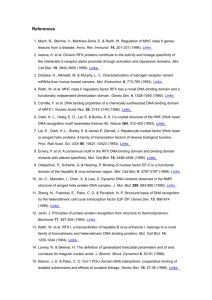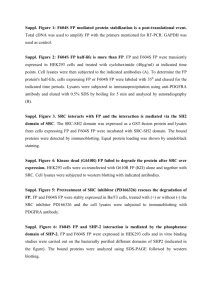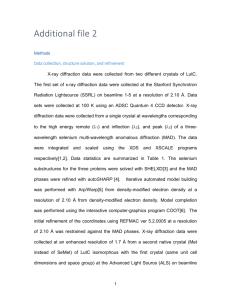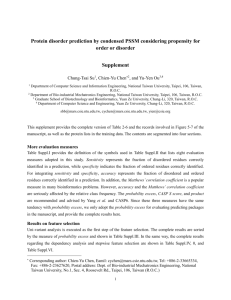Supplementary Notes 2 - Word file
advertisement
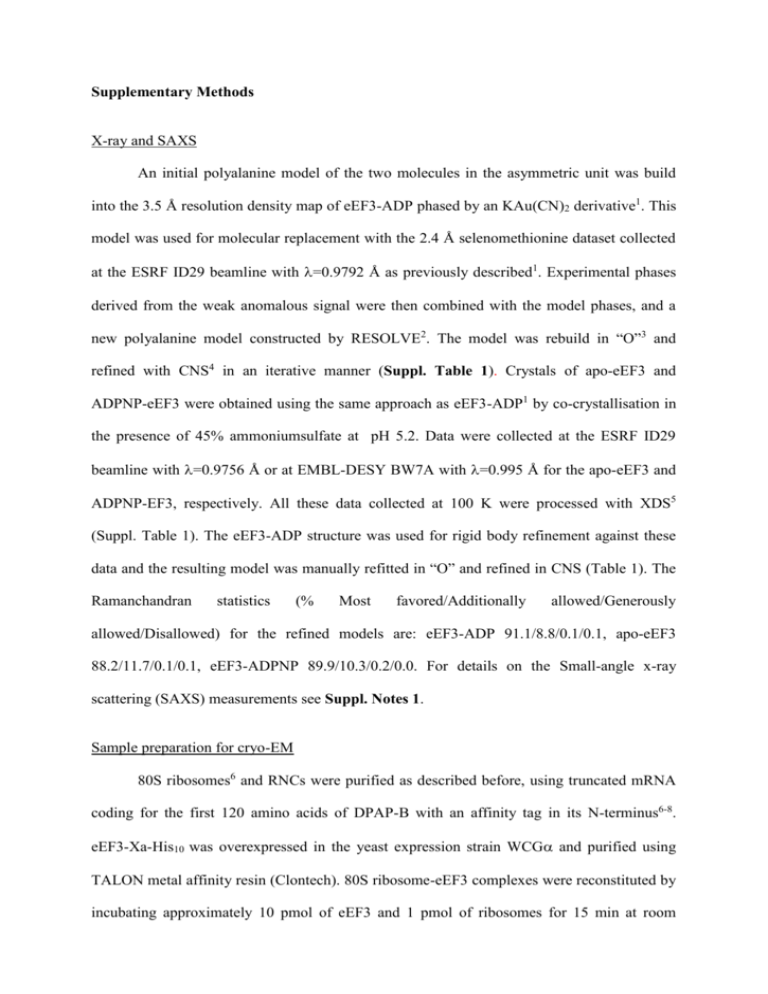
Supplementary Methods X-ray and SAXS An initial polyalanine model of the two molecules in the asymmetric unit was build into the 3.5 Å resolution density map of eEF3-ADP phased by an KAu(CN)2 derivative1. This model was used for molecular replacement with the 2.4 Å selenomethionine dataset collected at the ESRF ID29 beamline with =0.9792 Å as previously described1. Experimental phases derived from the weak anomalous signal were then combined with the model phases, and a new polyalanine model constructed by RESOLVE2. The model was rebuild in “O”3 and refined with CNS4 in an iterative manner (Suppl. Table 1). Crystals of apo-eEF3 and ADPNP-eEF3 were obtained using the same approach as eEF3-ADP1 by co-crystallisation in the presence of 45% ammoniumsulfate at pH 5.2. Data were collected at the ESRF ID29 beamline with =0.9756 Å or at EMBL-DESY BW7A with =0.995 Å for the apo-eEF3 and ADPNP-EF3, respectively. All these data collected at 100 K were processed with XDS5 (Suppl. Table 1). The eEF3-ADP structure was used for rigid body refinement against these data and the resulting model was manually refitted in “O” and refined in CNS (Table 1). The Ramanchandran statistics (% Most favored/Additionally allowed/Generously allowed/Disallowed) for the refined models are: eEF3-ADP 91.1/8.8/0.1/0.1, apo-eEF3 88.2/11.7/0.1/0.1, eEF3-ADPNP 89.9/10.3/0.2/0.0. For details on the Small-angle x-ray scattering (SAXS) measurements see Suppl. Notes 1. Sample preparation for cryo-EM 80S ribosomes6 and RNCs were purified as described before, using truncated mRNA coding for the first 120 amino acids of DPAP-B with an affinity tag in its N-terminus6-8. eEF3-Xa-His10 was overexpressed in the yeast expression strain WCG and purified using TALON metal affinity resin (Clontech). 80S ribosome-eEF3 complexes were reconstituted by incubating approximately 10 pmol of eEF3 and 1 pmol of ribosomes for 15 min at room temperature and then 10 min on ice in 20 mM HEPES/KOH (pH 7.5), 10 mM Mg(OAc)2, 150 mM KOAc, 1 mM dithiothreitol (DTT), 0.05% Nikkol, 125 mM sucrose, and, when present, 500 µM ADP, ATP or AMP-PNP and 100 µM neomycin in a final volume of 25 µl. For RNC-eEF3 complexes 10 µgxml-1 cycloheximide was present. Binding assays were performed using purified RNCs or empty 80S ribosomes with an excess of purified eEF3 in the presence of ADPNP and neomycin when indicated (RNCn). After sucrose density centrifugation supernatant (S) and pellet (P) fractions were analyzed by SDS-PAGE and Coomassie blue stain. Quantitation of eEF3 binding was done by densitometric determination of band intensity and setting the eEF3 binding in the presence of ADPNP and neomycin to 100%, while normalizing according to the intensity of ribosomal protein. For technical reasons, in order to so saturate the emerged signal sequence of the nascent chains which otherwise leads to biased orientation of the particles, purified trimeric Sec61 complex in 0.3% desoxyBigCHAPS (Calbiochem) was added8 for the structural study. EM and processing Reconstituted RNC-eEF3 complexes were applied on carbon-coated holey grids9 (Quantifoil) in the presence of Sec618, visualized on a 300 kV Polara cryo-microscope (FEI) and processed using the SPIDER software package as described7. The dataset (98,267 particles) was first sorted10 according to empty6 (32,782) or programmed8 (65,484) conformational state of the ribosome, followed by sorting according to presence of eEF3. 37,700 particles were used for the final reconstruction at a resolution of 9.9 Å (6.2 Å) based on Fourier shell correlation (FSC) of masked volumes at 0.5 (3). The resulting map is shown without the Sec61 density in Fig. 2 and 3 for better clarity (see Suppl. Fig. 6a for complete map). Docking into EM density Docking of X-ray structures and molecular models of eEF3 (based on MJ079611 and RLI12) and ribosomal proteins and RNA (PDB 1K5X, 1K5Y and 1K5Z)13 was done with IRIS Explorer, SPIDER14, O15 and ERNA-3D16. The models of the ribosomal proteins rpL11, rpL5, rpS5, rpS18 (residues 15-83) and rpS20 were adjusted as rigid bodies to fit into the density. The proteins rpL5 (residues150-232) and rpS18 (residues15-83) are truncated for better clarity. A model for the tip of the rRNA helix 39 (nucleotides 1354 to 1370) which is extended with respect to T. thermophilus rRNA was built in ERNA 3D16 by generating an Ahelix of 6 base pairs (G1354-C1360, G1365- U1370) and a tetraloop (A1361-1364). The molecular model of eEF3 bound to the ribosome was built on the basis of the ATP model of eEF3 based on MJ079611. After docking the ABC tandem into the density, the chromodomain was adjusted by a translation of approx. 5 Å and a rotation of approx. 53° relative to its position in the crystal structure with G762 and G864 serving as hinges (connecting it to the α-helical subdomain of ABC2). The HEAT domain was subdivided into two blocks consisting of the first 5 HEAT repeats (residues 1-200) and the following 3 HEAT repeats (residues 201-333). These blocks and the 4HB domain were docked as individual rigid bodies into the EM density. In detail, the first 5 repeats of the HEAT domain was flipped by 160° to fit into the density on the head of the 40S subunit. Afterwards, the last three HEAT repeats were moved for 15Å translation resulting in a contact with rpS18. Finally, the 4HB was moved approximately 10 Å towards the ABC1 domain. Using the program Situs 17 for docking of MalK based18 ADP and ATP models for eEF3 (cc of 0.7 for ATP and 0.62 for ADP state) confirmed our results with models based on MJ079611 and RLI12. Figures were produced with PYMOL19 and USFC Chimera20. Suppl. Legends Suppl. Table 1 Statistics of the crystallographic analysis of eEF3 No cutoffs based on the standard deviation were applied to intensities during merging or amplitudes during refinement. 1 Previously published in Andersen, C. F. et al. Acta Crystallogr D Biol Crystallogr 60, 1304- 7 (2004). 2 Values in parentheses are for outer shells. 3 Rmerge = (hj=1,N |Ih-Ih(j)| / N x Ih) for the intensity of reflection h measured N times 4 R-factor = h|Fo|-|Fc| / h|Fo|, where Fc is the calculated structure factor scaled to Fo 5 R-free is identical to R-factor on a subset of test reflections not used in refinement Suppl. Table 2 Molecular contact regions between eEF3 and the 80S ribosome Abbreviations: p indicates protein; R indicates ribosomal RNA. Amino acid residues and bases are given in the one letter code with residue #. S.c. and H.m. indicate that the nucleotide numbers refer to models based on the sequence of Saccharomyces cerevisiae 18S rRNA and Haloarcula marismortui 5S rRNA, respectively. Suppl. Figure 1. Sequence of Saccharomyces cerevisiae eEF3. The secondary structure representation above the sequence is colored according to domains: HEAT domain in blue, 4HB in yellow, ABC1 in red, ABC2 in green and the chromodomain in purple. The residue letters are colored according to conservation in an alignment of 16 known eEF3 sequences (Saccharomyces cerevisiae (eEF3A & eEF3B), Candida glabrata, Eremothecium gossypii, Kluyveromyces lactis, Clavispora lusitaniae, Debaryomyces hansenii, Candida albicans, Yarrowia lipolytica, Schizosaccharomyces pombe, Pneumocystis carinii, Aspergillus fumigatus, Aspergillus oryzae, Gibberella zeae, Chaetomium globosum, Neurospora crassa). Identical residues are designated by dark grey background and conserved (> 85% identical) by light grey background. The conserved sequence motifs of the ABC superfamily are indicated with boxes. Note that the Q-loop box in ABC1 does not contain a glutamine, but His496 may substitute for it. Suppl. Figure 2. a, Stereo view of ADPNP bound to eEF3 at the unusual nucleotide binding site. The electron density of ADPNP is generated from a 2Fo-Fc omit map contoured at 1.5 . Residues interacting with ADPNP are shown as sticks. b, The unusual nucleotide binding site of eEF3 compared to the canonical site modeled form the structure of RLI. The canonical ADP is prevented from binding to this site by the overlap with Phe35 (shown as sticks). c, The sulphate binding site formed by the signature motif (shown in green). The electron density of the sulphate ion is generated from a 2Fo-Fc omit map contoured at 1.5 . Suppl. Figure 3. Multiple alignment of eEF3 sequences from Saccharomyces cerevisiae (eEF3A and eEF3B), Candida glabrata, Eremothecium gossypii, Kluyveromyces lactis, Clavispora lusitaniae, Debaryomyces hansenii, Candida albicans, Yarrowia lipolytica, Schizosaccharomyces pombe, Pneumocystis carinii, Aspergillus fumigatus, Aspergillus oryzae, Gibberella zeae, Chaetomium globosum, Neurospora crassa. Suppl. Figure 4. SAXS analysis of eEF3. a-b, Background-subtracted SAXS data of eEF3 at pH 7.2 (a) and pH 5.2 (b) as a function of concentration before rebinning. From top: 10 mg/ml (red), 5 mg/ml (blue) and 2.5 mg/ml (green). c, Comparison of the two 10 mg/ml data sets of eEF3 at pH 7.2 (red) and 5.2 (blue) after logarithmic rebinning. d, Distance distribution functions obtained by GNOM for the two 10 mg/ml data sets of eEF3 at pH 7.2 (red) and 5.2 (blue). Dmax is respectively 125 Å and 110 Å. e-f, Theoretical SAXS curves of the crystal structure (red), cryo-EM structure (green), and ATP-model (blue) are fitted to the ph 7.2 (e) and pH 5.2 (f) data for q > qmin = 0.05 Å. g, Average envelope at pH 7.2 with the ATP-model superimposed. h, Average envelope at pH 5.2 with the crystal structure superimposed. Suppl. Figure 5. Nucleotide dependency of eEF3 binding. a, Binding assay using purified RNCs with an excess of purified eEF3 in the presence of ADP, ATP or ADPNP, respectively. Presence of neomycin (neo) is indicated. After sucrose density centrifugation supernatant (s) and pellet (p) fractions were analyzed by SDS-PAGE and Coomassie blue stain. Quantitation of eEF3 binding was done by densitometric determination of band intensity and setting the eEF3 binding in the presence of ADPNP to 100% while normalizing according to the intensity of ribosomal protein. Note, that maximum eEF3 binding is only observed in the presence of the nonhydrolyzable ATP analog ADPNP. The presence of the antibiotic neomycin stabilizes eEF3 binding also in the presence of ADP, however, not to levels observed with ADPNP. b, Fourier shell correlation (FSC) curve for the cryo-EM reconstruction of the yeast RNCeEF3 complex in the presence of ADPNP and neomycin. The resolution is 9.9 Å according to a cut-off of the FSC at 0.5 (6.2 Å at 3). Suppl. Figure 6. Complete eEF3-RNC-Sec61 density and difference map. a, The complete eEF3-RNC-Sec61 density is shown with extra density appearing for eEF3, which connects the head of the 40S subunit with the central protuberance of the 60S subunit. Note the additional density at the bottom of the 60S subunit which represents partial occupation of the exit site with Sec61. Since RNCs carrying a signal sequence were used for structure determination we added Sec61 to avoid signal sequence induced bias of particle orientation on the EM grid. b, The same map as in (a) is shown as wire mesh together with a difference map (red) at 3.5σ (top) and at 2.5σ (middle), comparing the eEF3-RNC-Sec61 density with a RNC-Sec61 map. Bottom: the difference map (red) is shown at 2.5σ together with the RNC-Sec61 map (blue surface). This difference map together with the RNC-Sec61 map allow very precise assignment of the eEF3 density and its boundaries. 1. 2. 3. 4. 5. 6. 7. 8. 9. 10. 11. 12. Andersen, C. F. et al. Purification and crystallization of the yeast translation elongation factor eEF3. Acta Crystallogr D Biol Crystallogr 60, 1304-7 (2004). Terwilliger, T. SOLVE and RESOLVE: automated structure solution, density modification and model building. J Synchrotron Radiat 11, 49-52 (2004). Jones, T. A., Cowan, S., Zou, J.-Y. & Kjeldgaard, M. Improved Methods for Building Protein Models in Electron Density Maps and the Location of Errors in these Models. Acta Cryst. A 47, 110-119 (1991). Brunger, A. T. et al. Crystallography & NMR system: A new software suite for macromolecular structure determination. Acta Crystallogr D Biol Crystallogr 54 ( Pt 5), 905-21 (1998). Kabsch, W. in International Tables for Crystallography (ed. Arnold, E.) Chapter 25.2.9. (Kluwer Academic Publishers, Dordrecht, 2001). Beckmann, R. et al. Alignment of conduits for the nascent polypeptide chain in the ribosome-Sec61 complex. Science 278, 2123-6. (1997). Halic, M. et al. Structure of the signal recognition particle interacting with the elongation-arrested ribosome. Nature 427, 808-14. (2004). Beckmann, R. et al. Architecture of the protein-conducting channel associated with the translating 80S ribosome. Cell 107, 361-72. (2001). Wagenknecht, T., Grassucci, R. & Frank, J. Electron microscopy and computer image averaging of ice-embedded large ribosomal subunits from Escherichia coli. J Mol Biol 199, 137-47. (1988). Penczek, P. A., Frank, J. & Spahn, C. M. A method of focused classification, based on the bootstrap 3D variance analysis, and its application to EF-G-dependent translocation. J Struct Biol (2006). Yuan, Y. R. et al. The crystal structure of the MJ0796 ATP-binding cassette. Implications for the structural consequences of ATP hydrolysis in the active site of an ABC transporter. J Biol Chem 276, 32313-21. Epub 2001 Jun 11. (2001). Karcher, A., Buttner, K., Martens, B., Jansen, R. P. & Hopfner, K. P. X-ray structure of RLI, an essential twin cassette ABC ATPase involved in ribosome biogenesis and HIV capsid assembly. Structure (Camb) 13, 649-59. (2005). 13. 14. 15. 16. 17. 18. 19. 20. Spahn, C. M. et al. Structure of the 80S ribosome from Saccharomyces cerevisiae-tRNA-ribosome and subunit-subunit interactions. Cell 107, 373-86. (2001). Frank, J. et al. SPIDER and WEB: processing and visualization of images in 3D electron microscopy and related fields. J Struct Biol 116, 190-9 (1996). Jones, T. A., Zou, J. Y., Cowan, S. W. & Kjeldgaard. Improved methods for building protein models in electron density maps and the location of errors in these models. Acta Crystallogr A 47, 110-9. (1991). Mueller, F. et al. Getting closer to an understanding of the three-dimensional structure of ribosomal RNA. Biochem Cell Biol 73, 767-73. (1995). Wriggers, W., Milligan, R. A. & McCammon, J. A. Situs: A package for docking crystal structures into low-resolution maps from electron microscopy. J Struct Biol 125, 185-95 (1999). Lu, G., Westbrooks, J. M., Davidson, A. L. & Chen, J. ATP hydrolysis is required to reset the ATP-binding cassette dimer into the resting-state conformation. Proc Natl Acad Sci U S A 102, 17969-74 (2005). DeLano, W. L. The PyMOL User's Manual (DeLano Scientific, CA, USA, San Carlos, 2002). Pettersen, E. F. et al. UCSF Chimera--a visualization system for exploratory research and analysis. J Comput Chem 25, 1605-12. (2004).


